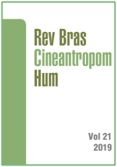Hemodynamic responses to strength exercise with blood flow restriction in small muscle groups
DOI:
https://doi.org/10.1590/1980-0037.2019v21e56258Resumen
The aim of this study was to analyze the acute hemodynamic responses to strength exercise with blood flow restriction involving small muscle groups. The sample consisted of 10 male volunteers (22.6 ± 2.07 years, 1.78 ± 0.06 m, 76.32 ± 13.36 kg) who randomly performed two experimental protocols involving the elbow flexion exercise with the dominant arm: strength exercise of the elbow flexors with blood flow restriction (EFBFR) and strength exercise of the elbow flexors without blood flow restriction (EEF). A cross-over design with a seven to ten days interval between the experimental protocols was used. Systolic blood pressure (SBP), diastolic (DBP) and mean (MAP), pulse pressure (PP), heart rate (HR) and double product (DP) were evaluated at rest, immediately after exercise and at 15 minutes of recovery. SBP, DBP and MAP presented a significant increase (p <0.05) immediately after EFBFR when compared to the protocol without blood flow restriction, returning to rest values at the 15 minutes of recovery. DBP significantly reduced (p <0.05) in the recovery period only in the EFBFR experiment and HR increased post-effort in both experiments. The PP and DP did not change between the different times, regardless of the protocol.The results of the present study allow us to conclude that strength exercise with BFR involving small muscle groups was more efficient than exercise without BFR to promote acute changes in hemodynamic responses and that BFR did not represent a cardiovascular risk considering its effects on PP.
Citas
De Sousa EC, Abrahin O, Ferreira ALL, Rodrigues RP, Alves EAC, Vieira RP. Resistance training alone reduces systolic and diastolic blood pressure in prehypertensive and hypertensive individuals-meta-analysis. Hypertens Res 2017;40(11):1-5.
Takarada S, Okita K, Suga T, Omokawa M, Kadoguchi T, Sato T, et al. Low-intensity exercise can increase muscle mass and strength proportionally to enhanced metabolic stress under ischemic conditions. J ApplPhysiol 2012;113(2):199-205.
Gonçalves ACCR, Pastre CM, Camargo Filho JCS, Vanderlei LCM. Exercício resistido no cardiopata: revisão sistemática. Fisioter Mov 2012;25(1):195-205.
American College of Sports Medicine. Progression models in resistance training for healthy adults: Position stand. Med Sci Sports Exerc 2009;41(3):687-708.
Scott BR, Loenneke JP, Slattery KM, Dascombe BJ. Exercise with blood flow restriction: an updated evidence-based approach for enhanced muscular development. Sports Med 2015;45(3):313-25.
Takano H, Morita T, Iida H, Asada K, Kato M, Uno K, et al. Hemodynamic and hormonal responses to a short-term low-intensity resistance exercise with the reduction of muscle blood flow. Eur J Appl Physiol 2005;95(1):65-73.
Figueroa A, ViciL F. Post-exercise aortic hemodynamic responses to low-intensity resistance exercise with and without vascular occlusion. Scand J Med Sci Sports 2011; 21(3):431-436.
Lixandrão M, Ugrinowitsch C, Berton R, Vechin FC, Conceição MS, Damas F, et al. Magnitude of muscle strength and mass adaptations between high-load resistance training versus low-load resistance training associated with blood-flow restriction: A systematic review and meta-analysis. Sports Med 2018;48(2):361-378.
Araújo JP, Silva ED, Silva JCG, Souza TSP, Lima EO, Guerra I, et al. The acute effect of resistance exercise with blood flow restriction with hemodynamic variables on hypertensive subjects. J Hum Kinet 2014;43(1):79-85.
Neto GR, Sousa MSC, Costa PB, Salles BF, Novaes GS, Novaes JS. Hypotensive effects of resistance exercises with blood flow restriction. J Strength Cond Res 2015;29(4):1064-1070.
Brown LE, Weir JP. Procedures recommendation I: Accurate assessment of muscular strength and power. J Exerc Physiol 2001;4(3):1-21.
Sociedade Brasileira de Cardiologia. 7ª Diretriz Brasileira de Hipertensão. Arq Bras Cardiol 2016;107(3) Suppl 3:1-103.
Rocha E. Influência da pressão arterial sistólica e pressão arterial diastólica a repercussão nos órgãos alvo. Rev FactoresRisco 2013;28(1):16-9.
Poton P, Polito MD. Hemodynamic response to resistance exercise with and without blood flow restriction in healthy subjects. Clin Physiol Funct Imaging 2016;36(3):231-236.
Spranger MD, Krishnan AC, Levi PD, O’Leary DS, Smith SA. Blood flow restriction training and the exercise pressor reflex: a call for concern. Am J Physiol Heart Circ Physiol 2015;309(9):H1440-1452.Passaro CL. Resposta cardiovascular na prova do esforço: pressão arterial sistólica. Ver Bras Med Esporte 1997;3(1):6-10.
Passaro CL. Resposta cardiovascular na prova do esforço: pressão arterial sistólica. Ver Bras Med Esporte 1997;3(1):6-10.
Casonatto J, Doederlein M. Post-exercise Hypotension: a Systematic Review. Rev Bras Med Esporte 2009;15(2):151-157.
Brandner CR, Kidgell DJ, Warmington SA. Unilateral bicep curl hemodynamics: Lowpressure continuous vs high-pressure intermittent blood flow restriction. Scand J Med Sci Sports 2015;25(6):770-777.
Downs ME, Hackney KJ, Martin D, Caine TL, Cunningham D, O’Connor DP, et al. Acute vascular and cardiovascular responses to blood flow – restricted exercise. Med Sci Sports Exerc 2014;46(8):1489-1497.
Pollock M, Franklin B, Balady G, Chaitman B, Fleg J, Fletcher B, et al. Resistance exercise in individuals with and without cardiovascular disease: benefits, rationale, safety, and prescription an advisory from the committee on exercise, rehabilitation, and prevention, council on clinical cardiology, American Heart Association. Circulation 2000;101:828-33.
Nogueira AR, Muxfeldt E, Salles GF, Bloch KV. A importância clínica da pressão de pulso. Rev Bras Hipertens 2003; 10(2):140-1.
Dart AM, Kingwel BA. Pulse pressure – A revision of mechanism and clinical relevance. J Am Coll Cardiol 2001;37(4):975-984.
Descargas
Publicado
Número
Sección
Licencia

Direitos Autorais para artigos publicados nesta revista são do autor, com direitos de primeira publicação para a revista. Em virtude da aparecerem nesta revista de acesso público, os artigos são de uso gratuito, com atribuições próprias, em aplicações educacionais e não-comerciais, desde que seja dada a atribuição. Esta obra foi licenciada com uma Licença Creative Commons Atribuição 4.0 Internacional - CC BY


